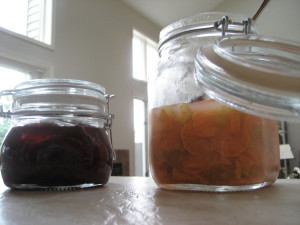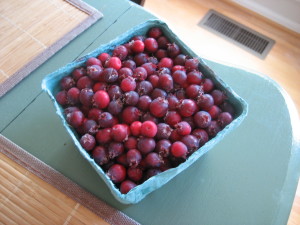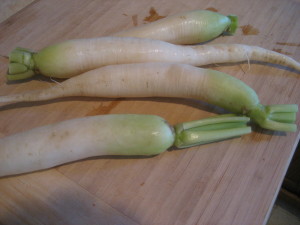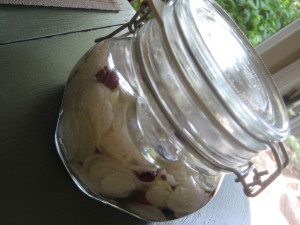
On the left: shredded beets with grated ginger and cayenne pepper. On the right: sliced sweet potato, celery, and chipotle pepper.
It started when I became interested in so-called “Resistant Starch” — a class of starches that are not digested in the small intestine, but instead pass through to the colon, where they become food for gut flora, including critters that are implicated in everything from weight loss/control to cooling inflammation.
I blogged about RS here. Also recommend Free the Animal, where Richard Nikoley has been rounding up info on RS and is writing a book on it with a couple other RS hero peeps. Details at his blog including his RS primer here.
From incorporating RS into my diet, I’ve now moved to two other refinements. First is adding other prebiotics, for example inulin, which I get by munching on things like raw sliced Jerusalem artichoke.
The second is more probiotics.
Not to go all old-timey on everyone, but I remember when eating probiotics was so new that the only place you really heard about it was in now-defunct alt-health magazines like East West Journal. I can remember people recoiling in horror when I suggested that consuming live bacteria might be a good thing.
Now you can’t walk through a supermarket dairy section without tripping over live yogurt cultures.

June berries, also called Service berries. The robins were *not* happy to catch me in their tree picking these.
There’s nothing wrong with eating yogurt, needless to say. But store-bought yogurt is made with commercially cultivated yogurt cultures. Same with store-bought probiotic supplements.
Which led me to the next question: what if you could easily incorporate wild strains of probiotics in your diet?
Turns out you can, by fermenting veggies.
Not going to do a primer here — no need to, because there are a zillion of them already, out on the web.
And for heaven’s sake, proceed at your own risk.
But I’ll say this much: what I’ve experienced so far has whetted my appetite considerably. My first attempt was with sweet potatoes (pic at the top of the post). I did that one with whey and let it ferment about a month, and wow it was sour! But the jar’s just about gone :)
My next experiment was with beets. Little more confident this time, so instead of adding whey (to seed it with lactobacillus) I salted it and let it ferment in its own brine.
I made 2 jars, and opened one after five days. The result is a crisp, salty, slightly tangy beet with terrific ginger flavoring and a little heat. Love love love. I’m going to let the second jar sit for a couple more weeks before I open. If I can restrain myself!
Third experiment was with beet greens, which I mixed with some chopped green garlic and a wedge of lemon. Similar to this recipe.
And now, because one of my goals is to use seasonal foods, comes #4: radishes with June berries (Service berries) and coriander.
No idea how this will taste in a month or so when I open it. But I can’t wait to find out :)
I’m winging things with the recipes, btw. I don’t want to make huge quantities of any particular recipe, so I’m using half-liter Fido jars. I calculate how much salt based on recipes I found online. Then I just slice or grate the veggies, add the salt, let them create their own brine, and hold the veggies down under the brine-line with some little glass rocks I bought here.
But I also bought this book, Wild Fermentation: The Flavor, Nutrition, and Craft of Live-Culture Foods, by Sandor Ellix Katz, which is really cool, and has recipes, plus ideas for fermenting other things besides vegetables. I am so going to make a batch of honey mead one of these days :)


